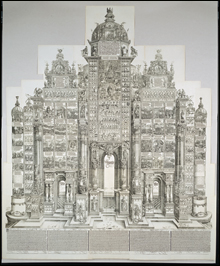Sizing things upMonumental Prints and Small Ponds at the Davis Museum, ‘Art and Math’ at Axiom, Glass Sea Creatures at Harvard, and New Rationalists at Proof March 10,
2008 10:45:03 AM

|
Back in the day — and by that I mean the 15th century — printing on paper was in its infancy in Europe, since the process of papermaking had just made its way there from China. Early prints were limited by the size of single sheets of paper and the size of a standard press, but by the 16th century, technological advances and artistic ambitions had led to the creation of large-format prints rivaling the most impressive Renaissance paintings and tapestries. Opening at Wellesley’s Davis Museum on March 19, “GRAND SCALE: MONUMENTAL PRINTS IN THE AGE OF DÜRER AND TITIAN” offers nearly 50 rarely seen, BIG 16th-century woodcuts, engravings, and etchings, among them Albrecht Dürer’s The Triumphal Arch of Maximilian I, which was completed in 1515 and measures over 11 feet in height. Also opening on March 19 at the Davis Museum, “JEM SOUTHAM: UPTON PYNE” presents large-format photographs chronicling the evolution of a small pond near Southam’s home in Cornwall that were taken during the artist’s regular walks to the pond between 1996 and 2001. The pond came into being as a result of industrial waste on the site of a former mine, and Southam documents the transformations caused by time and by humans.
“Grand Scale: Monumental Prints in the Age of Dürer and Titian” and “Jem Southam: Upton Pyne” at Davis Museum, Wellesley College, 106 Central St, Wellesley | March 19–June 8 | 781.283.2051
“Art and Math” at Axiom Gallery, 141 Green St, Boston | March 14–April 27 | 617.953.6413
“Sea Creatures in Glass” at Harvard Museum of Natural History, 26 Oxford St, Cambridge | March 20–January 4 | 617.495.3045
“The New Rationalists” at Proof Gallery, 516 East Second St, South Boston | March 15–April 26 | 508.963.9102
|
Photographs of fried eggs, Velveeta on pumpernickel, and lint may seem far removed from complex mathematical patterns, but artist Kevin Van Aelst’s images, using humble foods and household stuff as actors, help us visualize such configurations as Sierpinski’s gasket and the Cantor set and perhaps incline us to see nature’s designs in the world around us. Van Aelst’s photographs are on view in “ART AND MATH,” which opens at Axiom Gallery on March 14, together with work by Bathsheba Grossman, J. Michael James, and Keith Peters.
Nature’s bemusing designs are perhaps nowhere more evident than in marine invertebrates — that is, jellyfish, squid, sea slugs, and the like. In the mid 19th century, years before Harvard commissioned them to create the famed “Glass Flowers,” father-and-son artists Leopold and Rudolph Blaschka created lifelike glass replicas of soft-bodied sea creatures for universities and museums around the world. Sixty examples of their work are on view in “SEA CREATURES IN GLASS,” which opens at Harvard’s Museum of Natural History on March 20.
“Whip-smart abstractions” by New York painters Meghan Calhoun and Lauren Portada are on view in “THE NEW RATIONALISTS,” which opens at Proof Gallery on March 15, and I can only guess that these artists, working with geometric forms and painterly touches, aim to bring some semblance of order to that ineluctable tendency of abstraction, and of paint, to get sensual.
On the Web
www.wellesley.edu/DavisMuseum
www.axiomart.org
www.hmnh.harvard.edu
www.proof-gallery.com
|
 |

|
- Reconciling the irreconcilable
- In honor of National Boss Day, thePhoenix.com presents the ultimate kingpins
- The wars of evolution are louder than ever. What Ben Stein, Bad Religion, and a physics professor from Quincy can tell you about where you came from.
- Some Things at Trinity
- Never mind its tough-girl alt-porn feminism: SuicideGirls has already moved on to a new generation
- Inmate rehabilitation served on a platter
- How Herald publisher Pat Purcell could pitch inside — and brush back the Globe
- Nancy Goldner on Mr. B
- Swan Lake in Boston and Providence
- The wars of evolution are louder than ever. What Ben Stein, Bad Religion, and a physics professor from Quincy can tell you about where you came from.
- Berlioz’s Les Troyens at the BSO; Opera Boston attempts Verdi’s Ernani
- SFD students strut their stuff
|
-
Landscape anew at Mass MoCA, ‘Exposure’ at the PRC, Dana Clancy at the Danforth, and grouped figures at GASP
-
Botanical Forms at Harvard’s Museum of Natural History, Carroll Dunham and more at the Addison, and Renzo Piano at the Fogg
-
The DeCordova Annual, New Orleans after Katrina, ‘Superartificial,’ 19th-Century Leisure Travel, and El Chango Verde
-
‘Alexis Rockman,’ ‘The New Authentics,’ and ‘Paper Trail II’ at the Rose, and Chantal Akerman at MIT
-
‘Wedded Bliss’ at the Peabody Essex, Toys and Games at the Revolving Museum, and Chad Walker at Space 242
-
‘El Greco to Velázquez’ at the MFA, ‘Artadia Boston’ at the Mills Gallery, Harmonious Noise on the Roof at Tufts, and Animal Estates at MIT’s CAVS
-
Frank Gohlke at the Addison, ‘Pulp Function’ at the Worcester Center for Crafts, and ‘Expanded Sculpture 2’ at 119 Gallery
-
‘On Drawing’ at the New Art Center, Gateway Arts at Simmons, Jeff Koons at Harvard, and Jenny Saville at BU
-
“New England Survey” at the PRC, American Mobility at Gasp, 18th-Century Porcelain at the Busch-Reisinger, and Viktor Schreckengost in Attleboro
-
Spring Arts Preview: Landscape, road trips, weddings, and Spain
|

- The peculiar American brashness of George Bellows
- Walid Raad’s installations seek the “truth”
- The DeCordova Annual, New Orleans after Katrina, ‘Superartificial,’ 19th-Century Leisure Travel, and El Chango Verde
- ‘Alexis Rockman,’ ‘The New Authentics,’ and ‘Paper Trail II’ at the Rose, and Chantal Akerman at MIT
- Compelling new work by Neal T. Walsh and William Schaff
- ‘El Greco to Velázquez’ at the MFA
- ‘Wedded Bliss’ at the Peabody Essex, Toys and Games at the Revolving Museum, and Chad Walker at Space 242
- The mature art of longtime Maine artists
- Malcolm Grear at RIC; plus, Roger Mayer’s ‘Soundless’
- A local collective subverts with the tiny
|
|